Chapter 18.33
BUSINESS AND EMPLOYMENT DISTRICTS
Sections:
18.33.010 Establishment of zoning districts.
18.33.040 Development standards.
18.33.045 Certain standards inapplicable.
18.33.050 Site planning and design guidelines.
18.33.060 Performance standards.
18.33.070 Commercial/residential mixed use.
18.33.080 Parking and loading standards.
18.33.010 Establishment of zoning districts.
The city’s comprehensive plan establishes three land use designations that support the business and employment goals and policies of the city of Sequim. The three land use designations will also serve as titles of zoning districts on the city’s zoning map, and are identified as:
A. Bell Creek economic opportunity area (BCEOA).
B. River Road economic opportunity area (RREOA).
C. High tech light industrial (HTLI).
The three business and employment districts are intended to enhance Sequim’s economic base by providing suitable areas to support the employment needs of the community. The business and employment districts provide for the location of manufacturing, product processing, research and development facilities, assembly, warehousing, distribution, professional services, corporate headquarters, medical facilities and complementary educational and recreational uses among others. Limited retail, business and support services that generally serve the needs of the districts’ tenants and patrons as well as limited multifamily mixed residential/commercial uses are also allowed. All three districts are intended to expand and diversify the city’s economic base and increase the number and range of living-wage jobs. (Ord. 2019-002 § 1 (Exh. A))
18.33.020 Purposes.
A. The Bell Creek economic opportunity area (BCEOA) district provides for business and professional offices, corporate headquarters, research and development facilities, light industry/manufacturing and complementary retail, commercial, educational, recreational and limited multifamily residential uses. The district is not intended to support the general commercial needs of the community.
B. The River Road economic opportunity area (RREOA) district is intended to enhance the city’s economic base by providing for an integrated grouping of businesses and buildings of a larger size and scale than the BCEOA and HTLI districts may support. The RREOA district supports a variety of uses, such as light manufacturing, professional office buildings, retail, commercial, multifamily residential and warehousing and distribution.
C. The high tech light industrial (HTLI) district provides appropriate locations for combining light, clean industries, including industrial service, manufacturing, fabrication, assembly and production; business and technology research and development; and warehousing, distribution and storage activities. Uses are typically not reliant on unprocessed natural resources. Professional offices and sale of goods produced on site are subordinate to permitted activities. (Ord. 2019-002 § 1 (Exh. A))
18.33.030 Uses.
A. Types of Uses. For the purposes of this chapter, there are three kinds of uses:
1. A permitted (P) use is one that is permitted outright, subject to all the applicable provisions of this title and relevant portions of the Sequim Municipal Code.
2. A conditional use (C) is a Type C-2 discretionary use reviewed through the process set forth in SMC 20.01.100 governing conditional uses.
3. A prohibited use (X) is one that is not permitted in the zoning district under any circumstances.
B. Recognizing that there may be certain uses not mentioned specifically in Table 18.33.031 because of changing businesses, technology advances, or other reasons, the DCD director is authorized to make similar use determinations, as set forth in SMC 18.20.015.
The following Table 18.33.031 is a list of uses for the three zoning districts:
|
USE |
BCEOA |
RREOA |
HTLI |
|---|---|---|---|
|
Office and Professional Services |
|
|
|
|
All forms of corporate, professional, public, brokerage, administrative, financial, building trade, and research offices |
P |
P |
X |
|
Corporate headquarters and regional offices |
P |
P |
X |
|
Office-oriented service providers, such as communications services, photocopying, courier and messenger services, graphic design, printing, promotional products, and the like |
P |
P |
X |
|
Office equipment sales and services |
P |
P |
X |
|
Technology service and support, copy and connectivity centers, telework centers |
P |
P |
X |
|
Business/Technology Research and Development |
|
|
|
|
Biotechnology/medical laboratories |
C |
C |
C |
|
Computer technology |
P |
P |
P |
|
Electronic components and board systems engineering and development |
P |
P |
P |
|
Research and research industry-oriented service providers |
P |
P |
P |
|
Software engineering |
P |
P |
P |
|
Commercial Services and Retail |
|
|
|
|
Commercial convenience, personal services, and restaurant establishments |
P |
P |
X |
|
Commercial retail in conjunction with a primary use |
P |
P |
P |
|
Food service contractor/caterer |
P |
P |
P |
|
Food and drink where manufactured and sold on premises (on-premises tasting room, restaurant, and/or retail sales limited to 25% of gross square footage) |
C |
C |
C |
|
Nursery/landscaping materials retail sales |
C |
P |
X |
|
Wholesale product showrooms |
P |
P |
C |
|
Light Industrial |
|
|
|
|
Equipment rental |
X |
X |
C |
|
Industrial laundry and upholstery services |
X |
C |
P |
|
Resource recycling and recovery (not including recycling drop-off facilities) |
X |
X |
C |
|
Manufacturing |
|
|
|
|
Beverage products |
C |
P |
P |
|
Cabinet shop or carpenter shop |
X |
C |
P |
|
Electrical and electronic equipment manufacture |
P |
P |
P |
|
Electrical component assembly, including assembly of computer products, office equipment, and related components |
P |
P |
P |
|
Metal, wood and other materials fabrication and assembly in an enclosed building |
C |
C |
P |
|
Food and kindred products, manufacture, processing and packaging (excluding animal slaughtering and processing) |
C |
C |
P |
|
Furniture and fixtures manufacture and assembly |
C |
P |
P |
|
Handcrafted products, crafts or other art-related items |
P |
P |
P |
|
Measuring, analyzing and control instruments |
P |
P |
P |
|
Medical equipment and supplies |
P |
P |
P |
|
Miscellaneous light fabrication and assembly not otherwise named |
C |
C |
P |
|
Perfumes, cosmetics and similar preparations |
C |
C |
P |
|
Photographic, medical, audio and optical equipment |
P |
P |
P |
|
Printing, publishing and allied products |
C |
P |
P |
|
Products made from light stone, clay and glass |
P |
P |
P |
|
Textiles, apparel and leather goods |
P |
C |
C |
|
Warehousing, Distribution and Storage |
|
|
|
|
Equipment/materials outdoor storage as a primary use (including building trade and landscaping) |
|
|
|
|
a. Storage yards occupying less than 10,000 square feet |
X |
C |
P |
|
b. Storage yards occupying more than 10,000 square feet |
X |
C |
C |
|
Mail order or direct selling and distribution |
P |
P |
P |
|
Packing, crating and convention and trade show services |
P |
P |
P |
|
Processing and/or packaging previously prepared materials |
P |
P |
P |
|
Self-serve mini-storage |
X |
X |
X |
|
Truck and freight transportation services |
X |
X |
X |
|
Warehousing, product distribution, and wholesale trade |
X |
C |
P |
|
Residential |
|
|
|
|
Dwelling units above nonresidential uses (mixed use structures) (Nonresidential uses must be located on ground level or first floor if ground level is parking) |
P |
P |
X |
|
Employee/security units in conjunction with manufacturing, distribution or storage uses |
P |
P |
P |
|
Existing residential use without increase in density |
P |
P |
P |
|
(subject to nonconforming regulations) |
|
|
|
|
Live/work units |
P |
P |
X |
|
Public and Quasi-Public |
|
|
|
|
Essential public facilities, state and regional |
P |
P |
P |
|
Essential public facilities, local |
C |
C |
C |
|
Government maintenance shops and fleet vehicle storage |
C |
C |
P |
|
Public administration office and services |
P |
P |
P |
|
Public parks |
P |
P |
P |
|
Solid waste transfer facilities |
X |
X |
C |
|
Recycling drop-off facilities |
X |
X |
C |
|
Utility facilities and utility system |
P |
P |
P |
|
Transit facilities, including park and ride lots and transfer centers |
C |
C |
C |
|
Wireless communication facilities |
P |
P |
P |
|
Co-location of wireless facilities on existing facility or structure |
P |
P |
P |
|
Other |
|
|
|
|
Ambulatory and outpatient care services (physicians, outpatient clinics, dentists) |
P |
P |
X |
|
Child care centers |
C (as a secondary use) |
C |
C (as a secondary use) |
|
College, universities, technical, trade and other specialty schools |
C |
C |
C |
|
Grade schools (K – 12) |
C |
C |
X |
|
Hospital |
C |
C |
X |
|
Museums, historic and cultural exhibits |
P |
P |
X |
|
Privately owned amusement, sports or recreation establishments (retail sales limited to 25% of use’s total square footage) |
P |
P |
X |
|
Churches, new freestanding/monument structures and existing building(s) 5,000 square feet or larger |
C |
C |
X |
|
Churches, under 5,000 square feet and within an existing building(s) |
C |
C |
C |
|
Sports arena or stadium |
C |
C |
X |
|
Veterinary clinics and hospitals (not including kennels) |
P |
P |
X |
(Ord. 2019-002 § 1 (Exh. A))
18.33.040 Development standards.
For development standards, see Table 18.33.042 below.
|
Standard |
Bell Creek EOA |
River Road EOA |
HTLI |
|---|---|---|---|
|
Minimum/maximum lot area |
None |
None |
None |
|
Maximum height |
50 feet for single use building; 60 feet for mixed use building. Roof mounted mechanical equipment and its screening is not included in the height calculation. |
35 feet for single use building; 45 for mixed use building. Roof mounted mechanical equipment and its screening is not included in the height calculation. |
50 feet. Roof mounted mechanical equipment and its screening is not included in the height calculation. |
|
Maximum lot coverage |
Based on stormwater, parking, and landscaping standards per Chapter 13.104 SMC, Chapter 18.22 SMC, and SMC 18.24.130, respectively, but to also achieve FAR/density minimums |
Based on stormwater, parking, and landscaping standards per Chapter 13.104 SMC, Chapter 18.22 SMC, and SMC 18.24.130, respectively |
Based on stormwater, parking, and landscaping standards per Chapter 13.104 SMC, Chapter 18.22 SMC, and SMC 18.24.130, respectively |
|
Minimum setback and buffer adjacent to public right-of-way |
10 feet with additional landscaping and pedestrian connection to buildings |
10 feet with additional landscaping and pedestrian connection to buildings |
10 feet with additional landscaping and pedestrian connection to buildings |
|
Minimum setback and buffer when lot lines are adjacent to an R zoning district |
20 feet, plus an additional 1 foot for each foot the building wall facing an R district exceeds an average of 35 feet in height, to a maximum setback of 40 feet |
20 feet1 |
20 feet, plus an additional 1 foot for each foot the building wall facing an R district exceeds an average of 35 feet in height, to a maximum setback of 40 feet |
|
Minimum setback and buffer when lot lines are adjacent to a nonresidential zoning district |
Front yard: 10 feet Other yards: 5 feet Street (public or private) frontage: 10 feet Setbacks may be enlarged to provide additional area to meet overall site landscaping requirement |
Front yard: 10 feet Other yards: 5 feet Street (public or private) frontage: 10 feet Setbacks may be enlarged to provide additional area to meet overall site landscaping requirement |
Front yard: 10 feet Other yards: 5 feet Street (public or private) frontage: 10 feet Setbacks may be enlarged to provide additional area to meet overall site landscaping requirement |
|
Mixed commercial/residential use residential density |
No density threshold |
No density threshold |
N/A |
|
Attached residential density |
Minimum 12 units/acre |
Minimum 12 units/acre |
N/A |
|
Use mix threshold2 |
Office/professional/technology/ development/manufacturing/research, etc. = minimum of 55% of overall site |
N/A |
N/A |
|
|
Mixed use commercial/residential maximum of 30% of site |
|
|
|
|
Attached residential minimum 12 dwelling units/acre and maximum height of 4 stories. Maximum of 15% of site. |
|
|
|
Parking |
See SMC 18.33.090. See Chapter 18.48 SMC for additional parking standards. |
See SMC 18.33.090. See Chapter 18.48 SMC for additional parking standards. |
See SMC 18.33.090. See Chapter 18.48 SMC for additional parking standards. |
1No additional setback because 35 feet is maximum height limit in RREOA zone.
2Mixed use threshold based on Hovee report and not applicable to the RREOA and HTLI.
(Also see SMC 18.22.070, Commercial uses, for additional development standards applicable to the EOAs and HTLI zoning districts.)
(Ord. 2019-002 § 1 (Exh. A))
18.33.045 Certain standards inapplicable.
Standards identified in SMC 18.22.030, 18.24.050, 18.24.100, and 18.24.120 are inapplicable to development constructed in accordance with this chapter. (Ord. 2019-002 § 1 (Exh. A))
18.33.050 Site planning and design guidelines.
The following design guidelines are intended to guide the design process for development in the employment and business zoning districts and supersede Chapter 18.24 SMC:
A. Landscaping.
1. A minimum of 20 percent of the property area must be landscaped. Setback, parking lot, street trees and building perimeter landscaping contribute to this requirement.
a. Critical area buffers may count toward this requirement but cannot contribute more than 40 percent of the 20 percent overall site landscaping requirement.
b. Retaining land at its natural grade with existing native vegetation is strongly encouraged and may contribute toward the required landscape percentage requirement if the existing vegetation is healthy and likely to survive development. The city may require that the owner or developer post a maintenance bond complying with Chapter 3.78 SMC to ensure the existing vegetation remains healthy and that additional vegetation appropriate to the overall site’s landscape plan is installed if the existing vegetation does not survive.
c. Low impact development techniques for stormwater management that are not fenced and can be designed to integrate vegetation appropriately into the site’s overall landscape plan may count toward this requirement at the determination and approval of the review authority.
d. A two-year maintenance bond will be required for all landscaped areas required by this code. The maintenance bond will be for 125 percent of the landscaping costs.
2. Setback Landscaping.
a. Setback areas are to be landscaped and covered with live plant materials that will ultimately cover 75 percent of the ground area within three years. One tree (deciduous tree of a minimum of two inches caliper or one six-foot-high evergreen tree) and three shrubs, each of which will attain a height of three and one-half feet within three years, must be provided for every 300 square feet of area to be landscaped.
b. Setback landscaping may include low impact development stormwater management facilities that are not fenced and can be designed to integrate vegetation appropriately into the setback’s landscape area.
c. When adjacent to any R4-8/lifestyle zoning district, setback landscaping must be provided for the full width of the setback and include a combination of sight-obscuring fencing, solid screen of evergreen trees and shrubs and berming, as approved by the review authority.
3. Street Trees. Street trees and related landscaping must be provided 40 feet on center for arterials and 30 feet on center for collectors within a minimum five-foot planting strip. Groundcover of sod or other approved groundcover will be provided. Species of trees are as set forth in the city’s master street tree plan, if applicable, or as otherwise approved by the review authority.
4. Parking Lot Landscaping. Parking lots with more than 10 spaces must be landscaped. A minimum of five percent of the parking lot area (that area inside parking lot perimeter curbing) must be landscaped; planting areas must be a minimum of five feet in width. Providing adequate shading opportunities should be taken into account. Parked vehicles may not overhang if the planting area is the minimum width of five feet. Wheel stops will be required when any parking space abuts landscaping. Unfenced low impact development stormwater management facilities may be located in parking lot landscaping when feasible and when designed to be integrated appropriately in the landscaped area.
5. Building Perimeter Landscaping. For any building wall that exceeds an average of 30 feet in height and combined with an unmodulated wall exceeding 100 feet in length (not including loading areas), a planting bed is required, with a hierarchy of plantings for at least 60 percent of the wall’s length provided:
a. Columnar trees and large shrubs must be installed a minimum of four feet from the building’s foundation within a minimum six-foot-wide planting bed at the structure’s foundation/base; or larger trees may be planted 25 feet on center within a 15-foot planting bed and a minimum 10 feet from the building’s foundation.
b. Shrubs or small trees must be planted a minimum three to six feet on center (depending on size at maturity) within the required planting bed.
c. Groundcover or other organic material must be provided to reduce wind and water erosion.
B. On-Site Pedestrian Circulation.
1. Buildings must be linked to their fronting street(s) with primary walkways.
2. Primary walkways must be a minimum of five feet in width and must be visually distinct from parking lot and driveway surfaces. Pedestrian walkways may be of permeable surfacing when approved by the city engineer.
3. Secondary walkways are those that provide for pedestrian connection between buildings without depending upon parking lots. All buildings must be linked to each other by a secondary walkway promoting the shortest distance between building entrances. When adjacent to an undeveloped parcel, a secondary walkway must be provided to the property line to provide future pedestrian connection separate from a future street connection. Secondary walkways do not need to be paved.
C. On-Site Pedestrian Circulation.
1. Sidewalks to Be Constructed in Business and Employment Districts. The property owner must provide and fully develop sidewalks along the entire frontage of the subject property if there is any new construction or remodel of the primary structure of that property and (a) the street grade has previously been approved by the public works director or (b) if the curbs and gutters are currently in place along the access road abutting the subject property. Sidewalk construction must meet city standards and be completed before a building permit for the new construction or remodel will be issued. This provision applies to all allowed uses in any commercial or mixed use district.
2. Minimum Sidewalk Development Standards. Sidewalks must be established consistent with adopted city of Sequim standard plans, the standards contained within SMC Title 12, Streets, Sidewalks and Public Places, and SMC Title 17, Subdivisions. Where sidewalk depths are inconsistent, a transition area must be provided to avoid hazardous conditions. Primary walkways must be visually distinct from parking lot and driveway surfaces. Pedestrian walkways may be of permeable surfacing when approved by the city engineer.
D. Building Design Standards. The purpose of building design standards in the business and employment zoning districts is to facilitate attractive Pacific Northwest architectural design and scale by avoiding large blank walls, bright colors and providing roof line treatment. The following standards apply to building design in all three of the business and employment zoning districts. The city’s administrative design review process applies to all proposals that require site plan review or a building permit that contains substantial building facade alteration to the exterior of an existing building. See also Chapter 18.24 SMC.
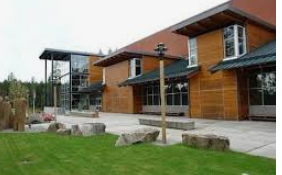
Figure 1
Example of Pacific Northwest architecture
1. Building Facades.
a. Architectural interest is required for all building facades visible from public streets and other publicly visible areas, such as parking areas.
i. Publicly visible building walls must incorporate insets or offsets, canopies, colonnades, wing walls, trellises, building facade landscaping, material variation, multi-planed roof line, or other features which diminish large blank walls.
Figure 2
Example of recesses and projections providing for interest in facade design
ii. For publicly visible building walls exceeding 50 feet in length, offset elements are required that break up the plane of the wall into at least three sections. Recesses and/or projections must have a depth of at least three percent of the facade’s length and extend at least 20 percent of the facade’s length.
Figure 3
Multiple facade treatment from color to building materials provides architectural interest in facades visible from the street
b. Provide visual terminus to tops of buildings. To avoid a truncated appearance, all structures must have a visual “cap.” Options include extended eaves; steep pitch hip, gable or saltbox roof form; false pitch roof with appearance of hip gable or saltbox; or projecting cornice of appropriate scale to the building and part of building’s trim detail.
c. Primary building entrances must be physically oriented to the street and primary pedestrian walkway. The primary entrances to structures, including all entrances to individual tenant spaces, must be clearly identifiable through architectural design. Specific treatments include, but are not limited to, wall modulation, arcades, overhangs, recesses/projections, raised and projected cornices, peaked roof forms, arches, gables, window clusters, landscape treatment, material/color/texture change, awnings, moldings, planters, balconies, and architectural details such as tile work and moldings which are integrated into the structure and pedestrian amenities, such as benches and tables.
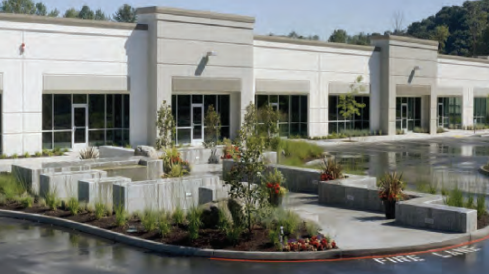
Figure 4
Multiple tenant building provides interest to entryways with offsets and color and architecturally interesting courtyard/plaza

Figure 5
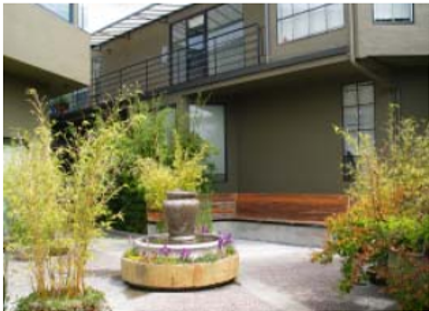
Figure 6
Courtyard with benches and planters
2. Materials.
a. Facades visible from public streets or other publicly visible areas must provide visual interest by providing a variety of building materials, windows, artwork, or other techniques. Desired materials include brick, wood, horizontal lap siding made of wood or cement-like materials, split-faced block or ground-faced block.
b. For structures including residential (mixed use structures) or live/work units, siding materials must include but are not limited to two of the following: horizontal lap siding (of any lap design) made of wood or cement-like materials, shingles made of cedar or cement-like materials, board and batten (or panels with similarly spaced battens), brick, or stone (real or cultured). Typically, the residential component will be differentiated from the nonresidential uses by scale and amount of detailing.
c. No unscreened facades visible from public streets and pathways may include the following:
i. Smooth-faced concrete block;
ii. Smooth-faced tilt-up concrete panels;
iii. Smooth-faced prefabricated steel panels;
iv. Prefabricated manufactured or modular units.
d. Blank walls are not allowed on any ground-level building wall abutting any form of public walkways or streets except as required for the structural integrity of the building. Buildings should be provided with a distinct “base” through the use of materials, texture or massing.

Figure 7
e. Buildings must provide generous amounts of windows, skylights, or similar natural light-producing products to create ground floors with a “transparent” quality and to enhance the use of natural light and reduce energy consumption. No window or door may consist of polished (mirrored) or highly reflective colored glass.
3. Color.
a. Main color of exterior walls is limited to subtle earth tone colors. Soft white, sands, grays, muted pastels, and deep, rich earth colors (terra cotta, forest green) are acceptable.
b. Trim color may be lighter or darker shades of the main color, soft white, or contrast or complement the main color but may not be bright or bold.
c. Accents or graphics may be brighter than main or trim color and are limited to 15 percent of the facade area, excluding glass. Bright, high contrast color banding is limited to maximum four inches in width. (Ord. 2021-021 § 1 (Exh. B); Ord. 2019-002 § 1 (Exh. A))
18.33.060 Performance standards.
No land or structure may be used or occupied unless there is compliance with the following minimum performance standards:
A. Outdoor Storage. Outdoor storage of materials and supplies must be completely screened, with a combination of fencing and landscaping, from adjacent properties and public right-of-way and be located in the interior of the lot to the extent possible as determined by the DCD director.
B. Recycling/Trash Enclosures. Recycling/trash enclosures will be screened and placed to the side or rear of each building. The enclosures will be made of the same or similar materials of that of the principal building to which the enclosure belongs.
C. Emissions. Any air emissions must meet applicable regulations of the Puget Sound Clean Air Agency, and no visible, frequent smoke, dust, or gases may be emitted.
D. Exterior Lighting. Exterior lighting, except for warning or emergency lighting, must be hooded or shielded so illumination is directed downward and confined to the property boundaries of the light source.
E. Noise. Noise levels may not exceed the maximum allowed in Chapter 173-60 WAC for Class B (commercial) or Class C (industrial) environmental designations as appropriate to the use, or as set forth in the International Building Code requirements.
F. Exterior Mechanical Equipment.
1. All HVAC equipment, pumps, heaters and other mechanical devices must be screened from view from adjacent streets and properties.
2. Vents, mechanical penthouses, elevator equipment and similar appurtenances may extend no more than 15 feet above the roof line, must be surrounded by a sight-obscuring screen constructed to the same height as the mechanical equipment, and conform to the following criteria:
a. The screen must be integrated into the architecture of the building.
b. The screen must obscure to the extent possible the view of the appurtenances from adjacent streets and properties.
c. Rod, wire and dish antennas are exempt from the screening requirement if the screening would interfere with the effective operation of the antenna.
G. Heat and Glare. Except for exterior lighting, operations producing heat and glare must be conducted within an enclosed building.
H. Ground and Soil Contamination. Materials must be handled in such a manner to prevent ground or soil pollution, or which may contaminate aquifer or other natural drainage systems, as required by state and local health agencies.
I. Fire and Explosive Hazards. The manufacture, use, processing or storage of flammable liquids or materials, liquids or gases that produce flammable or explosive vapors or gases is permitted in accordance with the regulations of the adopted International Fire Code and International Building Code.
J. In addition to the standards identified above, the city may utilize its authority under the State Environmental Policy Act (SEPA) to identify additional mitigations on impacts to the environment, as determined at time of project review. (Ord. 2019-002 § 1 (Exh. A))
18.33.070 Commercial/residential mixed use.
A. Mixed Use Structures1. Mixed use structures allow for placement of a mix of commercial, business, employment and residential uses in a single building. Mixed use structures are intended to allow for efficient use of land and public services in an urban setting; encourage convenient access between employment, services and residential opportunities; and increase development alternatives.
Figure 8
Mixed Use Building
Architectural interest achieved through a mix of building materials, overhangs, offsets and cornice treatment
1. Permitted nonresidential uses must be located on the ground floor. However, part of the ground floor may be used as a driveway to rear or under-building or under-grade parking, or as a public pedestrian park area. Residential units may be allowed in the rear 40 percent of the ground floor of a mixed use structure if that portion of the ground floor does not front a public street. In all other cases the residential units must be located above allowed nonresidential uses (residences may not be located at street/ground level or below except as allowed above). The number of residential units is limited by the mixed use structure’s required development standards (lot coverage, height, landscaping, parking and setbacks) for the underlying zoning district.
2. At least one outdoor activity feature must be provided for the mixed use building, including but not limited to courtyards, delineated gathering spaces, or seating areas. These areas may consist of hardscape and/or landscaping.
3. A minimum of 40 square feet of private open space must be provided for each of the residential units, such as a private outdoor balcony.
4. On-site pedestrian circulation that links the public street and the primary entrance to the structure or residential units must be provided. When the pedestrian circulation crosses driveways, parking areas and loading areas, it must be clearly identifiable through use of different paving materials.
5. Each unit will have an associated 30 feet of private on-site storage either in the units, garage, basement or, in some circumstances, the rear 40 percent of the structure’s ground floor if this area does not front a public street.
B. Live/Work Units. Live/work units are allowed in the BCEOA and RREOA zoning districts and are a building use that combines business or manufacturing activities within the same structure as a residential living space. Live/work units are distinctive from mixed use because the business owner or employee must live in the unit. In addition, they can provide affordable work and housing space, meet the needs of special groups such as artists, and serve to incubate new businesses.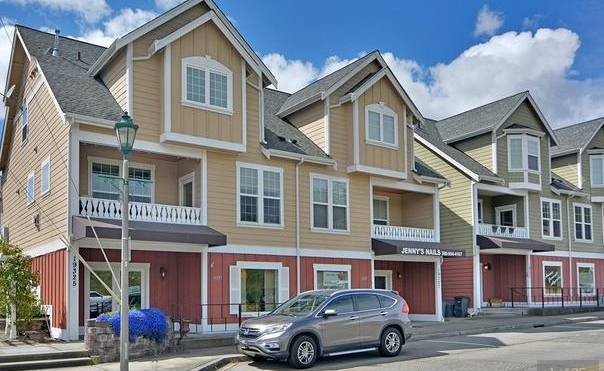
Figure 9
Live/Work Units
1. The total live/work unit is limited to 3,000 square feet in gross floor area.
2. The nonresidential use portion must be located on the first floor of the unit or, if parking is the first floor, the unit’s main floor area.
3. The nonresidential area is limited to 50 percent of live/work unit’s area.
4. Living space must be physically integrated and connected internally to the live/work unit and not be rented, leased, sold or occupied separately.
5. Private outdoor open space must be provided for the live/work units, such as a balcony or patio.
6. On-premises sales of goods are limited to those produced within the live/work unit or related to the permitted business activity.
7. A valid business license associated with the business or manufacturing activity must be obtained from the city.
8. Other restrictions may apply subject to the requirements of the adopted International Building Code. (Ord. 2019-002 § 1 (Exh. A))
18.33.080 Parking and loading standards.
The following standards apply to parking and loading in the BCEOA, RREOA and HTLI zoning districts. See SMC 18.48.050 for parking requirements for uses not listed below. All other applicable provisions from Chapter 18.48 SMC, except SMC 18.48.060, also apply.
A. Number of Spaces Required.
1. Office and professional services (except medical): one space per 300 square feet.
2. Business/technical research and development: one space per 500 square feet.
3. Medical office: one space per 200 square feet.
4. Hospitals: one space per longer-term care bed and one space for each 200 square feet of outpatient area.
5. Commercial Services and Retail.
a. Convenience and personal services: one space per 250 gross square feet.
b. Eating/drinking establishments: one space per table; plus one space per four stools; plus one space per employee based on largest shift.
6. Building trade/landscaping materials sales: one space per 300 square feet of retail area; and one space per 500 square feet of warehouse or storage area (including outdoor).
7. Food/drink manufacturing: one space per 500 square feet.
a. Food/drink with on-premises tasting room, restaurant and/or retail sales space: one space per 200 square feet.
8. Manufacturing: one space per 750 square feet.
9. Warehouse, distribution and storage: one space per 500 square feet.
10. Mixed use residential and live/work units: one and one-half spaces per residential unit in addition to other use required spaces, including additional customer/client and employee spaces for live/work units.
11. Ambulatory and outpatient care services: one space per 200 square feet.
12. Assembly uses: to be determined by DCD director at time of project.
13. Other uses not specifically listed above or in SMC 18.48.050 must furnish parking as required by the director based upon the most analogous use or through a parking study2.
B. When under-building parking is proposed in a business and employment zoning district and the structure fronts a collector or arterial street, at least 50 percent of street frontage (of the collector or arterial street) must include square footage that is to be occupied by permitted uses.
C. Parking or staging of delivery trucks on public streets is prohibited; provided, that smaller delivery trucks (e.g., UPS, FedEx) may park on public streets when on-street parking is available.
D. The primary vehicular access to businesses and loading areas must avoid a street that primarily serves residential uses.
E. Entrances and exits to and from parking and loading facilities must be minimized in number and clearly marked with appropriate directional signage.
F. Internal circulation must be designed for safety and efficiency by reducing conflicts between vehicular and pedestrian traffic, combining circulation and access areas where possible, and providing adequate truck maneuvering, stacking, and loading areas.
G. Loading facilities must be located internal to the site. Loading docks and doors facing a public street must be offset from the access drive and screened from the street as much as possible.
H. Driveways and parking areas must be landscaped, screened from residential areas, have shared driveways where possible and designed to meet ADA requirements.
I. Transit-oriented developments, approved as a planned unit development, or commercial uses, approved under the provisions of a binding site plan, may propose reduced parking requirements in lieu of provisions for alternate modes of transportation.
J. When possible, parking aisles will be separated from site circulation routes (see Figure 10).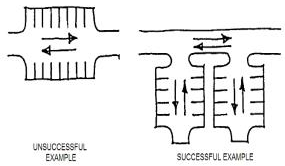
Figure 10
(Ord. 2019-002 § 1 (Exh. A))
18.33.090 Signage standards.
The following standards, which may deviate from Chapter 18.58 SMC, apply to signage in the BCEOA, RREOA and HTLI zoning districts. In cases where this chapter conflicts with Chapter 18.58 SMC, this chapter controls.
A. Wall-mounted signs will be no larger than 50 square feet; or one square foot per one foot of lineal facade area where the sign is affixed, not to exceed 200 square feet per sign, whichever is greater. In no case may the total length of all signs exceed 60 percent of the lineal feet of the building frontage (see Figure 11).
1. For multi-occupancy buildings, the facade area for each tenant or user is derived by measuring only the surface area of the exterior facade of the premises actually used by the tenant or use. One sign is allowed per tenant or use.
2. One wall-mounted sign as a business directory of the multiple-business building is allowed per street frontage and must be located near the entrance(s) to the building. The directory sign may not exceed 20 square feet.
3. Wall signs must be centered, proportional, and shaped to the architectural features of the buildings (see Figure 11).
4. No wall-mounted sign may extend above the height of the roof line or parapet of the building.

Figure 11
Wall Sign Placement
B. Freestanding/Monument Sign Area. The total allowable sign area for freestanding/ monument signs is 25 square feet or one-half square foot of sign area for each lineal foot of street frontage, whichever is greater, up to a maximum of 50 square feet of freestanding/monument sign area.
C. Height. The maximum height of a freestanding/monument sign located within five feet of the public right-of-way or private street is four feet. Signs set back a minimum of five feet are permitted a height of five feet plus one-half foot of height for each additional foot of setback exceeding five feet up to a maximum of eight feet in height. Any sign in excess of eight feet as permitted by this code in SMC 18.58.110(D)(5) must be set back a minimum of 10 feet.
D. Base Height Provision. The copy of all signage must be at least one foot above grade to allow vertical space for landscaping and to enhance the visibility of the sign (see Figure 12).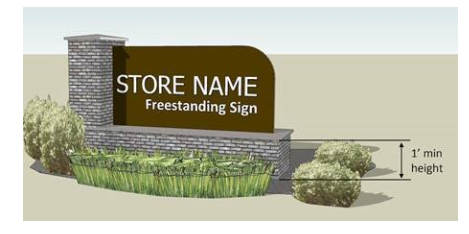
Figure 12
E. Location. No freestanding/monument signs may be located within any vision triangle or within 25 feet of the right-of-way of any street intersecting the street on which the freestanding/monument sign fronts.
F. Address Numbers. Legible address numbers are required on all freestanding/monument signs. Address numbers are exempt from sign area standards.
G. Freestanding signs do not include pole/pylon signs, which are prohibited – see Figure 13 below (SMC 18.58.070(B)).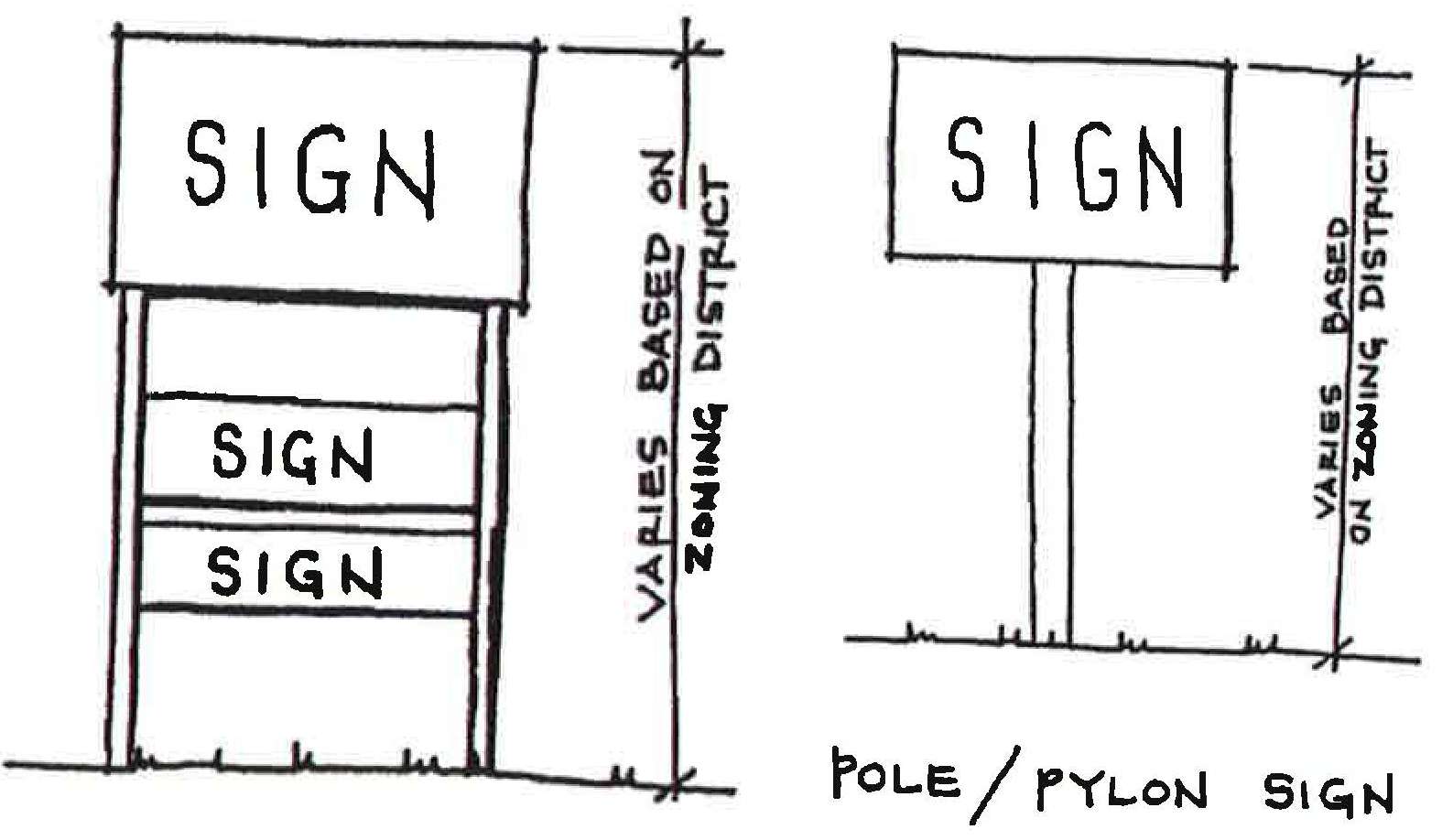
Figure 13
Prohibited Signs
1. No more than one freestanding/monument sign is permitted per multiple-occupancy building unless the building fronts more than one public street, where one additional freestanding/monument sign is allowed per additional street frontage. One sign may be located at the corner of two arterial streets upon which the building fronts in lieu of one sign on each street frontage if sign location is outside of the vision triangle.
2. All freestanding/monument signs must be located as close as possible to the center of the street frontage on which they are located.
3. All freestanding/monument signs must be located in a planting/landscaped bed of equal area to that of the sign. The planting bed may be included within a landscape/planting strip required in SMC 18.33.050. The minimum dimension of the planting bed must be five feet measured from inside face of curb to inside face of curb. The planting beds will be improved with the following:
a. One-gallon groundcover planted 12 inches on center; and
b. One shrub per 10 square feet of sign area. Shrubs located within the vision clearance area may not be taller than 36 inches at full height.
H. Multi-Building Business Development.
1. Each building in a multi-business center may have no more than one freestanding/monument sign unless the building fronts more than one public street, where one additional freestanding/monument sign is allowed.
2. One directory sign per entrance/exit for multi-business centers is allowed; provided, that the identification sign is no larger than 30 square feet and eight feet in height.
3. For horizontally mixed use projects permitted by the municipal code, a sign program, which implements the intent of this chapter, must be approved as part of the discretionary approval of the planned unit development, binding site plan or other allowed application process.
4. Directional signs may not exceed six square feet per face and must be located on the premises to which the sign is intended to guide or direct traffic. Directional signs are not included in the maximum number of freestanding/monument signs allowed.
5. Illumination of signs must not interfere with traffic, traffic control devices or the signs of others. Signs on awnings or canopies may not be illuminated internally if the light illuminates other than the sign.
6. No sign, except as otherwise permitted by this chapter, may be permitted that does not pertain directly to an approved use or business conducted on the premises. (Ord. 2019-002 § 1 (Exh. A))
18.33.100 Project review.
Before a building permit will be issued, the design review process and requirements found in Chapter 18.24 SMC must be followed. If a use is identified as a C, the conditional use and site plan review process will be consolidated. All project permits follow the process set forth in SMC Title 20, Land Use and Development. (Ord. 2019-002 § 1 (Exh. A))
For development standards for horizontal mixed use development see SMC 18.22.080, Mixed use.
Parking Studies. An applicant may request a modification, to be allowed by the approval body, to the minimum number of parking or loading spaces required, by providing a study from a qualified professional that substantiates that parking demand can be met with a reduced requirement due to such factors as drive-by trip capture, hours of operation, or alternative transportation availability for the customer base (SMC 18.48.070(C)).


